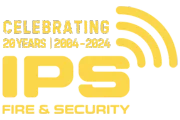CO2 Carbon Dioxide Fire Extinguishers – All You Need to Know
Carbon Dioxide (CO2) fire extinguishers are vital to fire safety, especially in environments with electrical equipment and flammable liquids.
This guide covers the essentials of CO2 extinguishers, including their primary uses, fire class suitability, limitations, identification, sizes, operation, advantages, disadvantages, typical applications, and usage instructions.
Quick links:
What fires are CO2 extinguishers used for?
CO2 fire extinguishers are primarily used for:
- Class B fires: Fires involving flammable liquids such as solvents, paint, petrol, and grease.
- Electrical fires: Including fires involving electrical panels, computers, and other electronic equipment, as CO2 does not leave any residue that can harm these devices.

Exclusions (what they should not be used for)
Understanding that CO2 fire extinguishers are unsuitable for all fire types is critical; this extinguisher type should not be used on:
- Class A fires (common combustibles like wood, paper, cloth) – as they do not cool the fire effectively, leading to possible re-ignition.
- Class C fires (gas fires) – as they cannot effectively stop the flow of gas.
- Class D fires (metal fires) and Class F fires (cooking oil fires), as they are ineffective and could potentially spread the fire.
How to identify them
CO2 fire extinguishers are typically identified by their black label and distinctive hard horn. This colour coding helps distinguish them from other types of extinguishers.
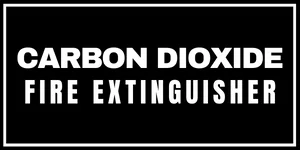
Common Carbon Dioxide extinguisher sizes
How they work
Pros and cons
Pros:
- Effective on electrical fires and Class B fires, leaving no residue.
- Non-conductive, safe for use on electrical equipment.
- Fast and efficient in extinguishing flammable liquid fires.
Cons:
- Not effective on Class A, C, D, and F fires.
- The discharge can cause frostbite if skin contact occurs.
- CO2 is heavier than air, but it can dissipate quickly, potentially allowing the fire to reignite.
- Limited cooling effect, which can result in re-ignition of flammable liquids.
- Can cause asphyxiation in confined spaces.
Fire extinguisher guide
Keep your people safe with us
Learn about the fire extinguishers variants and how they help extinguish the various fire types.
Common uses, what businesses typically use them
- Foam fire extinguishers are commonly found in:
- Electrical and server rooms
- Offices with electronic equipment
- Industrial and manufacturing
- Kitchens and catering establishments
- Laboratories and Research Facilities
- Entertainment venues
- Vehicle and aircraft maintenance
- Flammable liquid storage areas
Typical use cases for carbon dioxide (CO2) fire extinguishers

Typical use cases for carbon dioxide (CO2) fire extinguishers
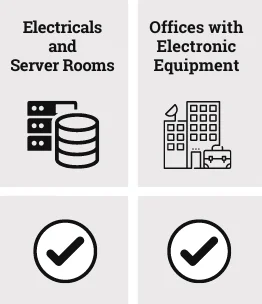
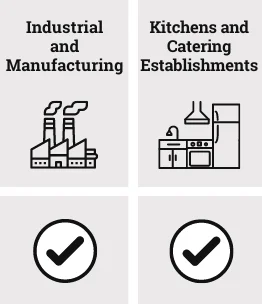
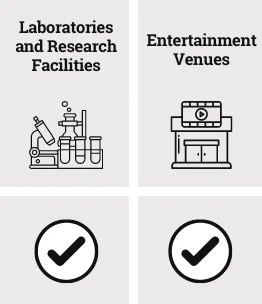
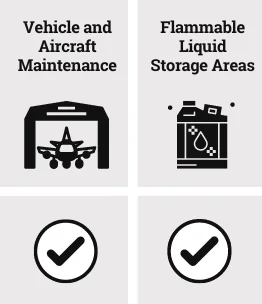
CO2 fire extinguishers are ideal for environments with a lot of electrical equipment or where flammable liquids are present.
Their ability to extinguish fires without leaving residue makes them a critical tool in protecting
sensitive equipment and environments from fire damage.
How to use a CO2 extinguisher
- Unplug or turn off electrical supply: where possible, always look to ensure power is off
- Do not hold the horn: CO2 extinguishers have a discharge horn that gets extremely cold during use; holding it can cause frostbite
- Aim low: Stand at a safe distance, aim the nozzle at the base of the fire.
- Squeeze the handle: This releases the CO2 gas.
- Sweep side to side: Move the nozzle in a sweeping motion to cover the area of the fire until it’s extinguished.
Ensure there’s proper ventilation to prevent asphyxiation risks when using CO2 extinguishers indoors. After use, it is vital to have the extinguisher refilled and checked by a professional.
Talk to us about your water extinguisher needs and your wider fire safety requirements
Talk to IPS Fire and Safety about your fire safety responsibilities. From an initial fire risk assessment to team fire safety training and the supply and fitting of fire extinguishers, we’re here to help you keep your people safe and meet your legal fire safety requirements.
Our Fire Safety services
FIRE RISK ASSESSMENTS
FIRE ALARMS
FIRE EXTINGUISHERS
FIRE SAFETY TRAINING
Total client protection since 2004
At IPS, your security is our priority. You need dependable protection 24/7, 365 days a year, and for that reason, our engineers are always available. You can depend on us to ensure you are always protected.
100% INDEPENDENT
We’re fully independent, providing unbiased solutions tailored just for you.
EXPERTISE
CUSTOMER-FIRST
COMPREHENSIVE COVERAGE
We're trusted by some fantastic organisations

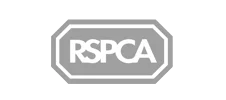



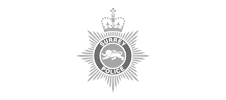
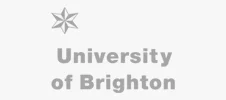

Contact us for a free quote
Or call the team on 0333 444 5 999
Our Priority is You
We pride ourselves on the impeccable service we provide our customers. From the first conversation to ongoing support for your fire, security and safety needs, you'll wonder why you left it so long to contact us.
